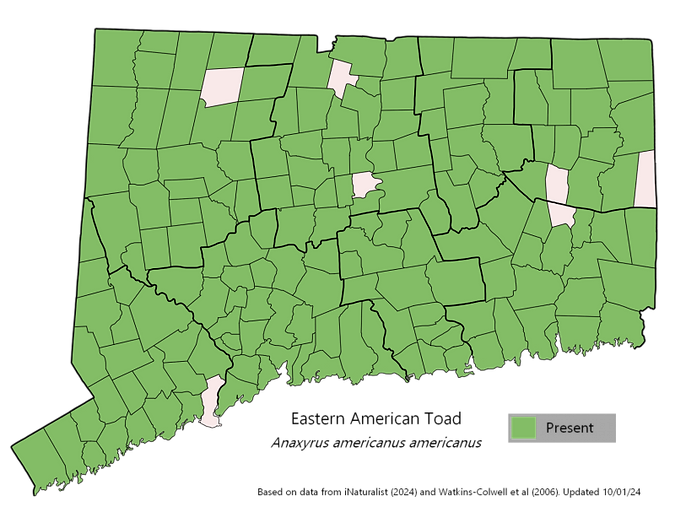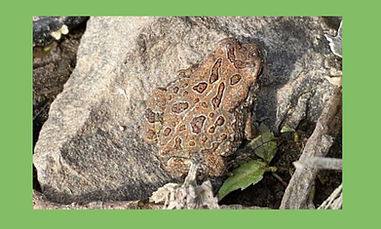Eastern American Toad
Anaxyrus americanus americanus
Conservation Status:
State Status: Secure (NatureServe, 2024)
Global Assessment: Least Concern (IUCN, 2020)
Listen to call:
(Green Gene, 2014)
Description
The American toad is a medium-sized frog, growing up to four inches long (Watkins-Colwell, 2024). They can range in color from gray to reddish-brown with a white belly. This species has dark spots on its back which contain large warts. They have dry skin and a short body. The parotoid glands are very prominent (the oval-shaped bumps behind each eye). Males will have darker throats than females during the breeding season.
Habitat
American toads are very common, being able to survive in areas that provide hiding places, burrowing soil, and food. They can be found in forests, fields, and residential areas.
Behavior
American toads dig burrows, where they will take shelter during the winter or other unfavorable conditions. They feed on small invertebrates like insects, slugs, and spiders.
These toads may be hunted by snakes, larger birds, or small mammals. They can inflate their body to appear larger if they feel threatened, and if ingested by predators they can release a toxin from their parotoid glands that cause them to be released (Quinn, 2020). American toads are also known to urinate as a defense mechanism when handled by humans.
This species will start breeding after they emerge in the spring. Males will gather in shallow waters and call out to attract females. Eggs are laid in long strings.
Range


Eastern American Toad
Photographed by Alyssa Jones
Often Confused with

Fowler's Toad
Photographed by Riley J
These two species of toads look very similar in appearance. American toads have enlarged warts on their hind legs and dark spots on their underside, while Fowler's toads lack these characteristics. Fowler's toads also tend to have larger groups of smaller warts clustered in the dark spots on their backs when compared to American toads, however this is a less reliable way to tell the two species apart.
References
Green Gene. (2014, April 2). American Toad - calling. YouTube. https://www.youtube.com/watch?v=ULB6phprgX8.
iNaturalist. (2024). Observations. California Academy of the Sciences / National Geographic Society. https://www.inaturalist.org/observations?place_id=49&taxon_id=64968.
International Union for Conservation Of Nature and Natural Resources. (2020, December 18). American Toad. https://www.iucnredlist.org/species/54570/193225406.
NatureServe. (2024, November 1). Anaxyrus americanus. https://explorer.natureserve.org/Taxon/ELEMENT_GLOBAL.2.102753/Anaxyrus_americanus.
Quinn, D. P. (2020). American Toad. Connecticut Herpetology. https://www.ctherpetology.com/eastern-american-toad.
Watkins-Colwell, G. J. (2024). American Toad - Bufo americanus. Yale Peabody Museum. https://peabody.yale.edu/explore/collections/herpetology/guide-amphibians-reptiles-connecticut.
Watkins-Colwell, G. J. et al. (2006). New Distribution Records for Amphibians and Reptiles in Connecticut, with Notes on the State of an Introduced Species. Sacred Heart University. https://digitalcommons.sacredheart.edu/cgi/viewcontent.cgi?article=1058&context=bio_fac.
Page updated November 16, 2024
